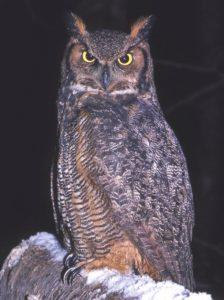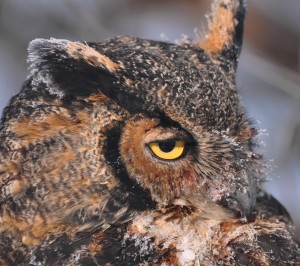Photography courtesy of Lowell Washburn, all rights reserved.
At long last, spring has finally arrived. Well, maybe not for you and me. We’re going to have to wait awhile. But for resident great horned owls, the change of seasons is here.
Often referred to as ‘Hoot Owl’, the great horned is the very first bird to begin nesting in Iowa each year. The species’ moonlight serenades are one of the most familiar sounds of the winter woodlands. Serious courtship begins in early winter and is accompanied by increased vocalizations. As the season progresses, the nocturnal caterwauling escalates to maniacal levels. The first eggs appear in mid-February and local females are already sitting on nests, patiently warming this year’s clutch of eggs.
Seemingly impervious to the elements, female horned owls are tough and dedicated mothers. While sitting atop her clutch of two or three eggs, a brooding female will endure a solid month of ice, sub-zero wind chills, and may even become buried in several inches of wet and heavy late season snow. But regardless of the duration and severity of the weather, the female doesn’t budge. To her, nothing is more important than the survival of the eggs.
For at least the next two months, the male will serve as a complete life support system for his nest bound mate and newly hatched chicks. Commonly referred to as Flying Tigers; great horned males are fierce and efficient hunters who take their family obligations seriously. Few predators — winged or otherwise — can match the unbridled savagery of a horned owl with a nest full of hungry babies. Although cottontails, tree squirrels, and small rodents provide standard fare, these huge owls will tackle virtually anything that flies, hops, or crawls. In spite of the fact that the annual prey base will never be lower than at winter’s end, horned owl families rarely — if ever — miss a meal.
At times, the horned owl’s diet may become somewhat controversial – especially when prey items include domestic poultry, pheasants or quail. This past weekend, my friend Ross Dirks and I hiked through a North Iowa woodlot where we discovered the remains of four recent pheasant kills in a fifty yard stretch. The distinct foot prints of a horned owl atop the snow left little doubt as to what had killed the roosting birds. Additional items that may be added to the owl’s menu include crows, muskrats, and stray cats. Horned owls will also kill and eat other raptors with the tiny screech owl ranking high on the list. A few years ago, a horned owl killed one of my favorite peregrine falcons during a late afternoon hunt. Determined to retrieve the falcon’s body, I chased the owl around for a half hour before it reluctantly dropped its prize.
Even striped skunks are not necessarily safe from the clutches of a hungry owl. Although I have never found skunk parts at a nest site, I have handled horned owls whose plumage reeked with the animal’s unmistakable odor. I can only assume that a freshly killed skunk must taste a whole lot better than it smells. 


 Tom Cope
Tom Cope Sue Wilkinson
Sue Wilkinson Susan Judkins Josten
Susan Judkins Josten Rudi Roeslein
Rudi Roeslein Elyssa McFarland
Elyssa McFarland Mark Langgin
Mark Langgin Adam Janke
Adam Janke Joe Henry
Joe Henry Kristin Ashenbrenner
Kristin Ashenbrenner Joe Wilkinson
Joe Wilkinson Dr. Tammy Mildenstein
Dr. Tammy Mildenstein Sean McMahon
Sean McMahon